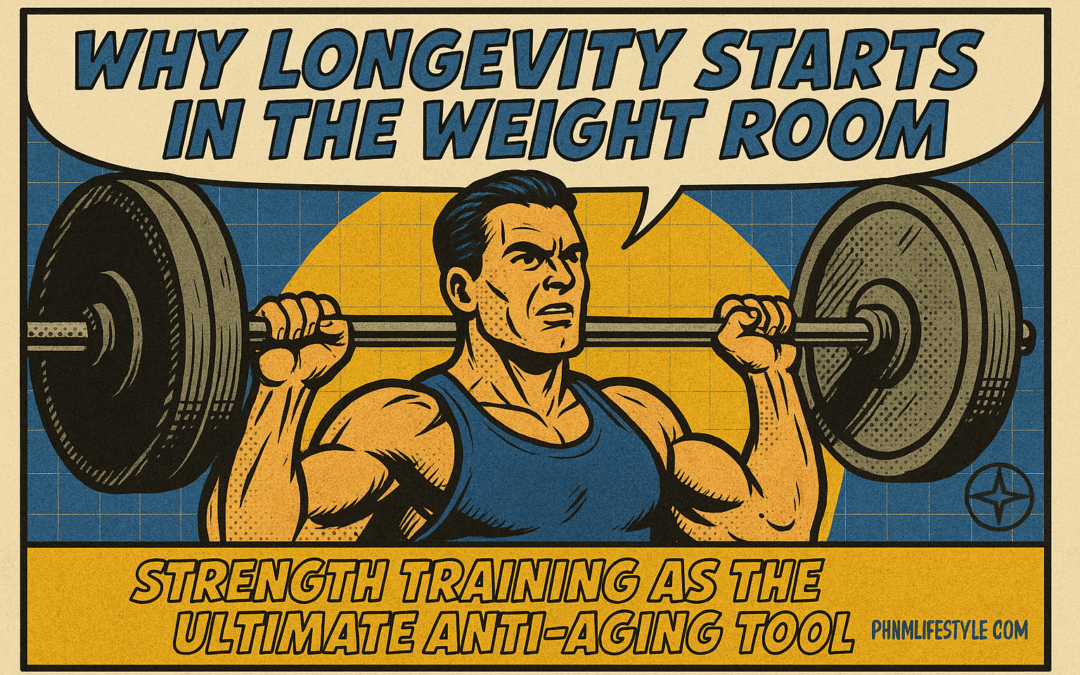Why Longevity Starts in the Weight Room: Strength Training as the Ultimate Anti-Aging Tool
Most people think of anti-aging in terms of skincare, supplements, or steps. But the real fountain of youth doesn’t come in a bottle, it’s built in the weight room.
If longevity is about living stronger, longer, then muscle is medicine. And the single best prescription is strength training.
The Real Meaning of Longevity
Longevity isn’t about simply adding years to your life, it’s about adding life to your years. It’s the difference between surviving and thriving. The ability to move well, stay independent, think clearly, and perform physically well into your 60s, 70s, and beyond depends on how much muscle and strength you maintain now.
After age 30, most adults lose 3–8% of their muscle mass per decade, a process called sarcopenia. Left unchecked, it leads to slower metabolism, reduced balance, insulin resistance, and decreased energy. But resistance training reverses that decline — it’s the closest thing to biological insurance you can buy with effort.
“Muscle isn’t vanity — it’s vitality.”
Muscle as Medicine
Muscle tissue isn’t just for aesthetics or performance. It’s a powerful metabolic organ that influences nearly every system in your body.
-
Improves insulin sensitivity: The more muscle you have, the better your body uses carbohydrates.
-
Regulates blood sugar: Active muscle acts like a sponge for glucose, helping prevent insulin resistance and type 2 diabetes.
-
Supports hormone balance: Strength training helps regulate testosterone, growth hormone, and other key longevity hormones.
-
Reduces inflammation: Regular lifting lowers chronic inflammation, a driver of aging and disease.
Muscle mass is so tightly linked to health that studies show people with higher lean mass have a lower risk of all-cause mortality. Simply put, the more muscle you carry into your later years, the more likely you are to live longer and live better.
The Hormonal Edge of Strength Training
One of the biggest markers of aging is hormonal decline, particularly testosterone, growth hormone (GH), and IGF-1. Resistance training is one of the few natural interventions proven to elevate or maintain all three.
For men, lifting helps preserve testosterone production and combat age-related loss of vitality. For women, it’s equally important: strength training improves bone density, stabilizes mood, enhances metabolism, and supports estrogen balance through peri- and post-menopause.
The takeaway: while most people chase hormones through external means, training naturally optimizes your internal chemistry, without the side effects.
More Than Muscle: Strength and Longevity Biomarkers
When you lift weights, you’re improving far more than your physique. You’re positively impacting nearly every biomarker associated with a long, healthy life:
-
VO₂ max: Stronger muscles improve your oxygen uptake and cardiovascular efficiency.
-
HRV (Heart Rate Variability): Regular training and recovery improve your body’s ability to handle stress.
-
Bone density: Loading your skeleton keeps your bones strong and resistant to fracture.
-
Metabolic rate: More muscle means higher calorie burn at rest, keeping body fat in check without extreme dieting.
-
Mitochondrial health: Strength work enhances your cells’ energy factories, improving endurance, recovery, and vitality.
That’s why people who strength train consistently are more mobile, metabolically healthy, and mentally sharp later in life, not because they chase youth, but because they build resilience.
Building Your Longevity-Focused Strength Plan
So how do you train for longevity instead of just aesthetics? You keep the core principles simple and consistent.
1. Lift Heavy (for You)
You don’t need to chase personal records, but you do need to challenge yourself. Aim for 2–4 strength sessions per week focusing on compound movements, squats, presses, rows, and deadlifts. These exercises hit multiple muscle groups and drive full-body adaptation.
2. Prioritize Movement Quality
Control matters more than chaos. Train with intention, good posture, full range of motion, and controlled tempo. Moving well today is the best predictor of moving freely tomorrow.
3. Recover Like It’s Part of the Program
Longevity isn’t built in the gym; it’s built in recovery. Sleep 7–9 hours, walk daily, hydrate, and don’t ignore mobility or stretching. A strong body needs downtime to repair and adapt.
4. Eat for Muscle Maintenance
Protein intake is critical. Aim for roughly 0.8–1g per pound of body weight daily to preserve lean mass. Pair that with whole foods rich in omega-3s, fiber, and micronutrients that fight inflammation.
5. Stay Consistent
The secret to lifelong strength isn’t complexity, it’s consistency. You don’t need a new program every month. You need decades of showing up.
Why Strength Is the Real Fountain of Youth
When you look at people who age well, not just live long, but live strong, they all share a few traits: they lift, move, eat protein, and take recovery seriously.
Strength training is unique because it doesn’t just extend lifespan; it expands healthspan, the number of years you can live fully functional, mobile, and independent.
It keeps you upright when balance fades, confident when energy dips, and capable when life demands resilience.
“Longevity isn’t found in a lab. It’s forged under a barbell.”
The PHNM Philosophy
At PHNM, we believe strength is freedom. The weight room isn’t about ego or aesthetics, it’s where you build the physical and mental durability to handle whatever life throws at you.
Longevity doesn’t belong to those who avoid challenge, it belongs to those who embrace it. Every rep is a vote for your future self.
So if you care about living better, not just longer, it’s time to pick up the weights.
Your future depends on it.

